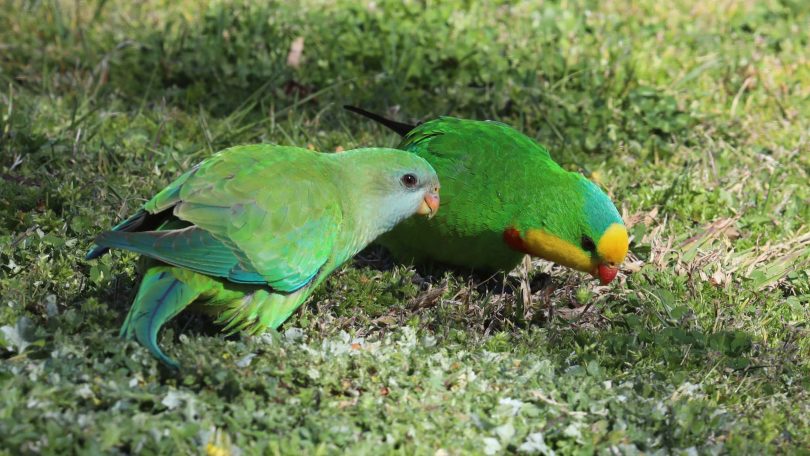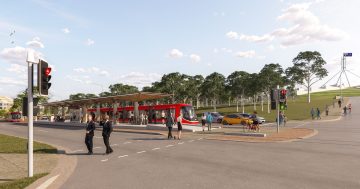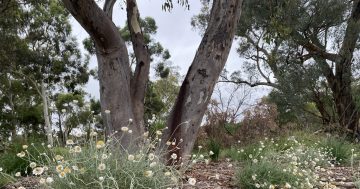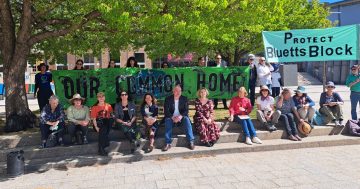
A female superb parrot on the front lawns of Parliament House pauses to look towards David Flannery’s camera while its male mate feeds. Photos: David Flannery.
Superb parrots are as rare as good news from Parliament House. But architect and bird photographer David Flannery has captured both with this striking pair of vulnerable superb parrots feeding on the front lawns of Parliament House.
Canberra Ornithologists Group, which has more than 50 years of data for the territory, has tracked the rise of superb parrots. Once rarely if ever seen here, superb parrots have been recorded in Belconnen and North Canberra, and the annual COG Garden Bird Survey reports sightings in Curtin and Kambah.
COG president Neil Hermes, who was instrumental in the 1970s when working for NSW Parks Service in having the superb parrot placed on the endangered species list, says interest in birds in Canberra has grown strongly ever since the filling of Lake Burley Griffin, coinciding with the construction of major dams, wetlands and wildlife corridors.
A report from North America released last week found three billion fewer birds there since the 1970s.
“What that report doesn’t say is the reason for that decline, and it is across all species. But I would suggest in terms of our own data in the ACT, we have done the reverse,” Mr Hermes said.
“I imagine there are more birds, certainly in the suburban areas of the territory than there would have been 50 years ago,” he said.
“Not just from the wetlands we have built; we have planted millions of trees and shrubs on what was a grassland. Sure, grassland birds are rarer on the edge of town, but it means we have this extraordinary wealth, and huge biodiversity of species within the city itself as a consequence of water, shrubs, trees, hollow trees and the design of green belts in all of the suburban areas.”
Mr Hermes says superb parrots were endangered due to trapping, agriculture, poisoning of wheat and loss of hollow trees.
“Where they were rare, they have become more regular in Gungahlin and Belconnen and now all through the city down to Tuggeranong, where they were almost unheard of and now we get them at Parliament House,” he said.
“I’m not saying they are out of danger in NSW, but we are certainly doing our bit in the ACT to protect the superb parrots.”
Environment ACT says the species arrives in the ACT in August to breed and leaves in January. Yellow box-red gum grassy woodland is their major habitat. In the wider region, efforts at Harden and Boorowa have been made over many years to cover grain to avoid spillages along roadside edges. Last year the NSW Government provided $400,000 to help farmers and land managers look after hollow-bearing trees.
Mr Hermes says action at the local level makes a difference.
“We in Canberra should be proud of what we have done over the 100 years of our history. We have in the ACT, when compared with other states and countries around the world, one of the largest percentages of conservation areas of any territory on the planet. We have about 55 per cent of our landmass as conservation land. Most countries are happy with 10 or 5 per cent.”

“I’m not saying they are out of danger in NSW, but we are certainly doing our bit in the ACT to protect the superb parrots,”Mr Hermes says.
Mobile phone apps have boosted COG’s data gathering, making recording of species easier than ever for the annual garden, woodland and wetlands surveys.
“Our challenge is in the management, the back end, how we keep up with the technology which can’t necessarily be done with volunteers, or without money,” Mr Hermes said. “It is a challenge to make it accessible and kept in a format which can be rigorously analysed.”
For information about COGS annual bird blitz on 26 and 27 October, go to Canberrabirds.org.au, pick out your own grid and join the blitz.
Last year’s bird surveys show increases or improvement for the territory’s beautiful parrots. The number of sightings of red-rumped parrots has been steadily improving since a low point in 2002, the king parrot is increasing, while the crimson and eastern rosellas have recorded rates higher than the long-term averages. Like the superb parrot, the rainbow lorikeet has been increasing steadily over the last five years.
Magpies once again topped the sightings. Others in the top 10 were magpie-lark, crimson rosella, sulphur-crested cockatoo, pied currawong, red wattlebird, Australian raven, galah, superb fairy-wren and crested pigeon.
















